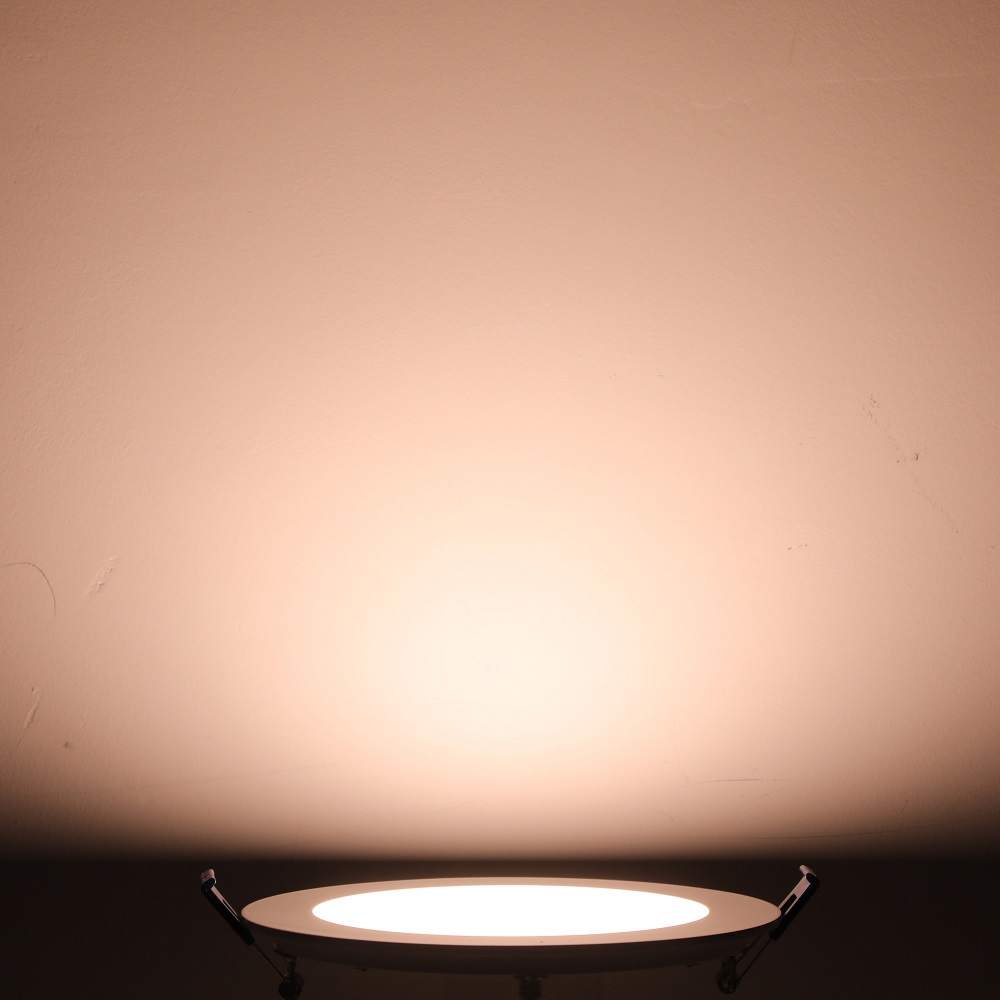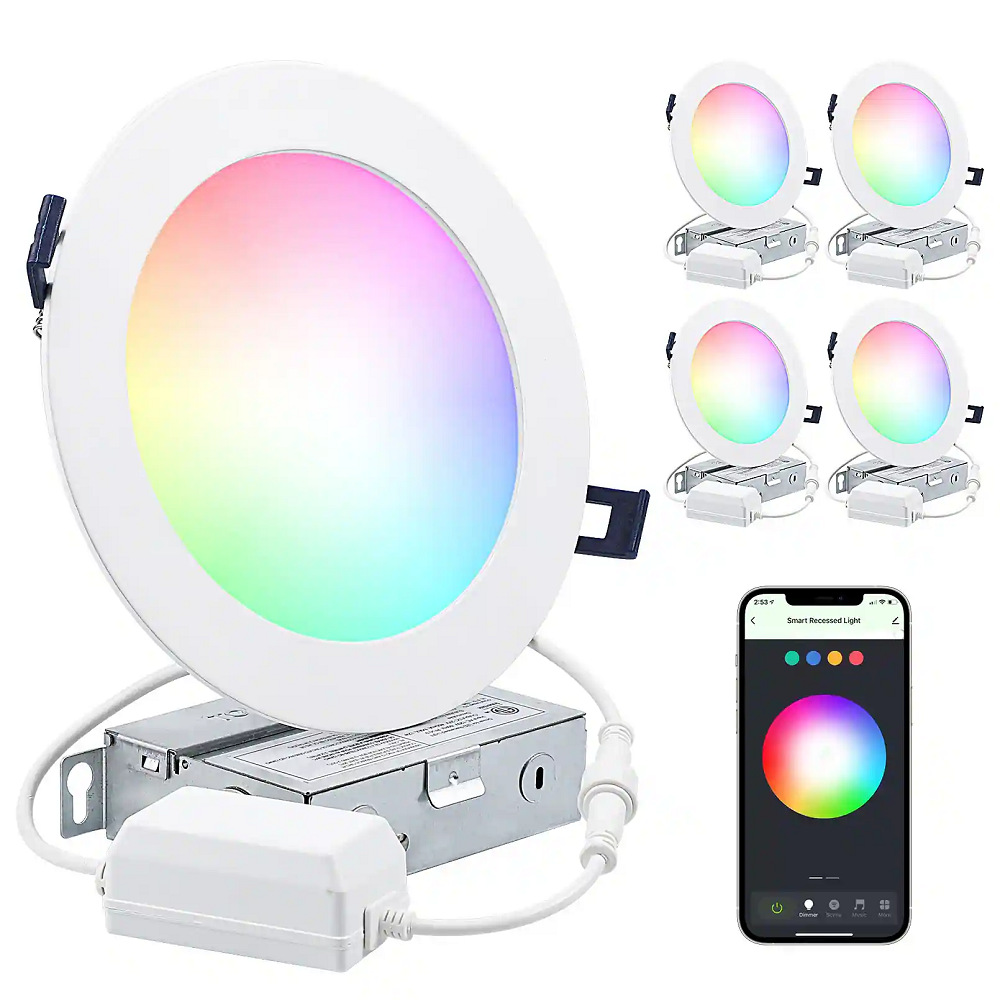The Basics of Smart Recessed Lighting
Understanding the basics of smart recessed lighting is key to integrating it seamlessly into your home.
What is Recessed Lighting?
Recessed lighting, often called downlighting, is a lighting fixture installed into a hollow opening in a ceiling. It shines light downward, like a broad floodlight or a narrow spotlight. These lights are sleek because they blend with the ceiling, without parts hanging down or jutting out. Many people choose them for their modern look and feel.
The Evolution to Smart Lighting
Smart recessed lighting takes the concept of recessed lighting further by adding the ability to control and automate lighting through devices. Over the years, lighting has seen major advancements. From the traditional manual switch, we now have lights that work with mobile apps and smart home systems. Smart technology in recessed lights offers features like dimming, color temperature change, and scheduling. These lights not only provide the function of illumination but also become a part of home automation, creating the perfect ambiance at any time.

Benefits of Smart Recessed Lighting in Your Home
The adoption of smart recessed lighting comes with a variety of benefits that enrich living spaces in multiple ways.
Energy Efficiency and Cost Savings
Smart recessed lighting is a choice that benefits both your wallet and the environment. These lights often use LED technology, which consumes up to 75% less energy than traditional bulbs. The ability to control and automate lighting means no wasted electricity from lights left on. Dimming features allow for reduced power usage without sacrificing comfort. Over time, these savings add up, making smart recessed lighting a cost-effective investment.
Convenience and Control Through Automation
Imagine adjusting lights with just a voice command or a simple tap on your smartphone. Smart recessed lighting brings this convenience. It integrates with home automation systems, so you can set schedules for lights to turn on or off. Whether you’re at home or away, you can manage lighting to fit your routine. The automation not only makes life easier but also adds a layer of security, simulating occupancy when you’re not there.
Enhancing Home Aesthetics and Atmosphere
Smart recessed lighting transforms living spaces aesthetically. With a variety of color temperatures and brightness levels, you can create the desired ambiance for any occasion. The seamless integration of these lights into your ceiling ensures a clean and modern look. You can highlight artwork or architectural features, or set a cozy mood in your living room. So, not only does it cater to functionality, but it also enhances the beauty of your home.
Installation Tips for Smart Recessed Lights
Integrating smart recessed lighting into your home requires careful planning and the right approach. To ensure the process goes smoothly, follow these essential installation tips.
Choosing the Right Type of Smart Bulbs
Select smart bulbs compatible with your existing home automation system. Look for energy-efficient LED bulbs with adjustable color temperatures for a versatile lighting experience. Choose bulbs that fit the size of your recessed lighting fixtures and have a good lifespan.
Necessary Tools and Precautions
Before installation, gather all necessary tools, such as a ladder, screwdriver, and drill. Ensure the power is off at the circuit breaker to avoid electric shock. Wear safety gear like gloves and goggles for protection.
Step-by-Step Installation Guide
- Turn off power at the circuit breaker.
- Remove the existing bulb and trim from the recessed fixture.
- If applicable, install the smart bulb adapter into the fixture.
- Screw in the smart bulb firmly but gently.
- Replace the trim, ensuring it fits snugly against the ceiling.
- Turn the power back on and sync the smart bulb with your home automation system.
- Test the smart bulb to confirm installation success and functionality.
Smart Recessed Lighting Compatibility
Ensuring your smart recessed lighting is compatible with your smart home ecosystem is crucial. Compatibility enhances the functionality and ease-of-use of your lighting system.

Integration with Smart Home Ecosystems
Smart recessed lighting should work smoothly with your home’s automated systems. Check for compatibility with platforms like Apple HomeKit, Amazon Alexa, or Google Assistant. This ensures seamless control of your lighting alongside other smart devices. Many smart bulbs connect via popular communication protocols such as Wi-Fi, Zigbee, or Z-Wave. Choose ones that align with your system to avoid connectivity issues.
To set up, follow the smart device manufacturer’s instructions. Use their app to pair your smart lights with your home network. After this, integrate them with your wider smart home system. Set rules or create scenes that include lighting for the perfect home ambiance.
Voice Control and Smart Assistants
Voice control takes convenience to a new level. Look for smart recessed lighting that is compatible with voice-controlled smart assistants. With a simple voice command, control the light’s on/off state, brightness, and even color. This hands-free operation is particularly helpful when your hands are full or if you’re in a different room.
Ensure you have a compatible smart assistant device like Amazon Echo or Google Home. Through voice commands, manage your lights without a physical interface. This feature is a step towards more accessible and user-friendly home environments.
Choose bulbs that are certified to work with these assistants for smooth integration. Set up is usually as simple as connecting your smart lighting to the same network as your assistant device.
When selecting smart recessed lighting, considering compatibility with your home ecosystem and voice control capabilities is important. These factors greatly impact the ease with which you can control and automate your home’s lighting.
Smart Recessed Lighting Features
Smart recessed lighting brings a host of features to enhance user experience.
Brightness and Color Temperature Adjustment
Adjusting brightness and color temperature is a breeze with smart recessed lighting. Control lights to match your mood or activity with just a few taps or voice commands. Set lights to a warm glow for a cozy evening, or bright white for focus and energy during work. These adjustable settings are not just for comfort. They also help reduce eye strain and create the right atmosphere for each room.
Scheduling and Scene Setting
Another great feature of smart recessed lighting is the ability to schedule when your lights turn on and off. Plan lights to switch on at sunset, or turn off when it’s bedtime. For special events, set scenes where lights change to festive colors or dim to a soft ambiance. These features save energy and add a layer of convenience and security to your home. Use scene setting for a party or a quiet dinner to transform your space instantly.

Top Smart Recessed Lighting Brands and Products
Choosing smart recessed lighting means selecting from the best brands. Here’s an overview.
Overview of Market Leaders
Leading companies like Philips Hue, LIFX, and Wiz offer top-rated smart recessed lighting. Philips Hue is known for high-quality lights and a wide range of features. LIFX shines with vibrant colors and Wi-Fi capabilities. Wiz provides cost-effective solutions with easy integration.
What to Look for When Buying
When buying smart recessed lighting, consider compatibility, ease of installation, and energy efficiency. Check for dimming and color options to match your space. Don’t forget to read reviews and compare prices. Choose smart recessed lighting that fits your smart home’s ecosystem for seamless operation.
Maintenance and Troubleshooting
Maintaining smart recessed lighting ensures its longevity and optimal performance.
Cleaning and Care for Longevity
To keep smart recessed lighting in top shape:
- Turn off power before cleaning. This step is crucial for safety.
- Dust the fixtures gently with a soft cloth or duster.
- Avoid using water or harsh chemicals that can damage the lights.
Regular cleaning helps prevent dust buildup, which can dim lights over time.
Solving Common Issues with Smart Recessed Lights
Common issues with smart recessed lighting often have easy fixes:
- If lights won’t turn on, check the power source first. Ensure the circuit breaker is on.
- Bulbs not responding might need a reset. Turn off for 10 seconds, then back on.
- Connectivity problems? Check the Wi-Fi network or smart home hub connections.
For persistent issues, consult the product manual or contact customer support for assistance. Troubleshooting is often simple and does not require a professional.
Future of Smart Recessed Lighting
The future of smart recessed lighting shines bright with advances in technology.
Trends in Smart Home Lighting Technology
As technology evolves, so does smart home lighting. New trends focus on sustainability and interconnectivity. Energy-efficient designs are becoming standard. Wi-Fi-enabled lights offer more control and integration with other smart home devices. Expect to see lights with improved color accuracy and brightness. User-friendly apps make customization straightforward and hassle-free. Voice-activated controls continue to gain popularity, making lighting even more accessible.
Smart lighting systems are learning to adapt. They can now analyze usage patterns. This helps them adjust settings for optimal comfort and energy use. Lights can also interact with other smart devices. This creates a more seamless and intuitive home environment.
The Potential of AI in Recessed Lighting
Artificial Intelligence (AI) is transforming smart recessed lighting. AI can automate settings based on the time of day or season. It can also detect room occupancy. The lights can turn on or off as needed, saving energy. Advanced algorithms allow for personalized lighting experiences. They can adjust to your routines and preferences over time.
AI’s potential in lighting also includes predictive maintenance. It can notify you before a bulb needs replacement. This can extend the life of your lighting system. AI developments hold promise for making homes smarter and more responsive to our needs. As AI technology grows, the abilities of smart recessed lighting will continue to expand.
